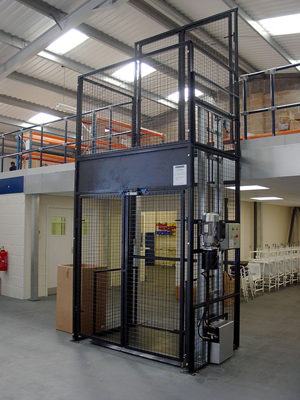
Many garages and workshops want to add storage space to stock more spares and components for a wider range of vehicles. Others want to introduce new services or capabilities but find that limited floor space prevents them from developing their business. A combination of mezzanine floor and simple goods lift can offer an excellent and cost effective solution in each of these situations. With something like 38,000 premises providing vehicle service and repair facilities in the UK there is a lot of potential space to gain.
Often it is impossible to extend an existing building because of lack of available development land, planning considerations or simply because it costs too much. Under these circumstances the addition of an upstairs store or mezzanine floor offers an excellent way to add more space and free up valuable workshop areas for productive and profit generating activities. However this will introduce the new challenge of how to handle items safely and efficiently between the two levels. Provision for this must take into account the health and safety regulations including those covering manual handling.
This is important because, according to the HSE's latest figures, around 37 per cent of all major injuries, leading to three or more days off work, in the vehicle repair sector are caused by manual handling such as lifting or carrying. A further 25 per cent of serious injuries are caused by a slip, trip or fall (from level ground or less than two metres).
The current manual handling regulations recommend that nobody should lift frequently an item weighing 25kg or more on their own. In fact, the guidelines recommend significantly lower weight limits if the task is repetitive or the person is handling loads throughout the day.
Carrying items up and down stairs is often considered a simple solution. However, if the item needs to be held with both hands then employees they will be unable to use a hand rail which will increase the risk of slips, trips and falls. Similarly, large or bulky items, whatever their weight, can restrict employees' ability to see where they are walking which can also increase the risk of accidents. Besides, the amount of time spent handling items in this way can soon mount up and is often counter productive.
The only way for a business to remain compliant with the regulations and fulfil their duty of care to employees is to use some form of mechanical handling. In many applications a goods lift such as the Penny Hydraulics MezzLift offers a practical and affordable solution that allows items to be transferred quickly and efficiently between levels so that staff remain productive and avoid unnecessary carrying and lifting.
The MezzLift is designed to be simple to specify, install and operate and is delivered within four weeks of the order. Its compact structure is free-standing and all of the electrical components and hydraulic services are self-contained. This means that it can be installed in almost any position, indoors or out, without the need to excavate a floor pit, make structural changes to the building or provide additional electrical services. This simplifies installation and reduces costs and also makes it much easier to reposition the lift should the need arise.
Devices such as the MezzLift allow users to match the configuration very closely to the job in hand. It can be supplied with bespoke platforms while a choice of standard designs, including versions which stop at waist height, allows operators to meet their individual requirements without taking up space unnecessarily. The maximum working load is generally in the 250-500kg class which covers the vast majority of automotive service and repair applications. Robust construction and simple design combine to promote reliability and ease of use. Training is straightforward and maintenance issues are kept to a minimum, all of which helps to control overall life time costs.
One of the biggest advantages of the MezzLift is that it does not require the same level of safety certification as a people-carrying lift. However, like any other piece of lifting equipment, it is covered by the normal LOLER and PUWER regulations which means it must undergo a statutory thorough inspection at least once a year. These regulations are designed to ensure safety but are not as onerous as those covering lifts designed for people carrying.